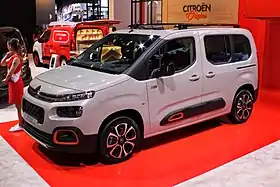Citroën Berlingo
The Citroën Berlingo and Peugeot Partner are almost identical panel vans and leisure activity vehicles produced by PSA Peugeot Citroën since 1996. The third generation is also sold as the Opel/Vauxhall Combo, and as the Toyota ProAce City from 2019.
| Citroën Berlingo | |
|---|---|
 | |
| Overview | |
| Manufacturer | Citroën Peugeot |
| Production | 1996–present |
| Assembly | Villa Bosch, Argentina (Sevel) Poissy, France (PSA Poissy Plant) Casablanca, Morocco (Somaca Casablanca Plant)[1] Mangualde, Portugal (PSA Mangualde Plant) Vigo, Spain (PSA Vigo Plant) Akçalar, Turkey (Karsan)[2][3] Barra de Carrasco, Uruguay (Oferol, Grand Berlingo) Nysa, Poland (FSO) |
| Body and chassis | |
| Class | Leisure activity vehicle Panel van Pickup truck (Partner II) |
| Body style | 4/5-door panel van 5-door LAV 2-door pickup truck (Partner II) |
| Layout | Front-engine, front-wheel-drive |
| Chronology | |
| Predecessor | Citroën C15 Peugeot 305 Panel Van |
The panel vans are available in passenger versions named the Berlingo Multispace and Partner Combi, Partner Tepee, and Peugeot Rifter for the third generation. In Italy, the first generation of the Partner was known as the Peugeot Ranch. They were initially based on the Citroën ZX/Peugeot 306 estate floorpan and mechanicals.
With their rectangular, box like cargo space and aerodynamic front, conceptually they can be considered the descendants of the Citroën 2CV panel van (AK400). The new 2018 Citroën Berlingo and Peugeot Partner/Rifter also share their design with the new Vauxhall/Opel Combo, following GM's stake acquisition in PSA.
Both the Berlingo and Partner have been produced in CNG and electric versions and with four-cylinder petrol and diesel engines.
Berlingo / Partner I (M49; 1996)
| First generation | |
|---|---|
 | |
| Overview | |
| Also called | Doninvest Orion M (Russia) Peugeot Grand Raid (Mexico) Peugeot Ranch (Italy) Citroën Berlingo Multispace (South America) Peugeot Partner M69 (Uruguay) Citroën Berlingo Business (Uruguay) Peugeot Partner Origin (Europe, after 2nd generation launch) Citroën Berlingo First (Europe, after 2nd generation launch) Off-road look models : |
| Production | 1996–2008 (Original versions, including Multispace) 2008–2013 (Peugeot Partner Origin, and Citroën Berlingo First) 1998–present (Argentina) |
| Model years | 1997–2013 1998–present (Argentina) |
| Body and chassis | |
| Class | Leisure activity vehicle (M) |
| Body style | 4/5-door panel van 5-door LAV |
| Powertrain | |
| Engine | 1.4 L TU3 I4 (petrol) 1.6 L TU5 I4 (petrol) 1.8 L XU7 JB / LFX I4 (petrol) 1.6 L DV6 I4 (diesel) 1.9 L DW8 I4 2.0 L DW10 HDi I4 |
| Transmission | 5-speed manual |
| Dimensions | |
| Wheelbase | 2,695 mm (106.1 in) |
| Length | 4,135 mm (162.8 in) |
| Width | 1,820 mm (72 in) |
| Height | 1,725 mm (67.9 in) |
The Berlingo/Partner was officially launched in July 1996.[4]
When the Berlingo was first shown at the Mondial de l'Automobile (Paris Motor Show) in 1996, a set of three concept cars was also presented:
- Berlingo Coupé de Plage
- Berlingo Berline Bulle
- Berlingo Grand Large
The Berline Bulle concept was a roomy small car, that could be considered as a precursor for the C3. Only one of these concepts was actually developed, the Grand Large version, which was developed into the Multispace and Combi people carriers/leisure vans.
Unti 2010, the pre-facelift models were still produced in Argentina. The updated model finally arrived this year.[5]
 Pre facelift Citroën Berlingo
Pre facelift Citroën Berlingo Pre facelift Peugeot Partner van
Pre facelift Peugeot Partner van
Facelift M59 (2003-currently)
A revised version, featuring a redesigned interior and front end, was released in December 2002 (Berlingo I / Partner I).
During 2004, there was a minor facelift, including changes to the grille and light clusters.
After the launch of the second generation Berlingo and Rifter, the first generation models stayed offered. They took the names "Citroën Berlingo First" and "Peugeot Partner Origin".
In 2010, the Citroën Berlingo First Electrique and the Peugeot Partner Origin Electric were launched. These two electric vans were powered by the Monégasque firm Venturi, which assembled them in Solesnes, Sarthe.[6]
From 2013, the Berlingo and the Partner were discontinued in Europe. Their career continued in South America, where they are still produced years after.[7]
In Argentina, Peugeot launched an off-road version of its Partner, called Partner Patagónica. This model had various names when it was sold across Europe in the 2000s (Partner Ushuaïa Grand Raid, Partner Escapade, Partner Grande Escapade, Partner VTC, Partner Indiana, ...).
_van_(22082762158).jpg.webp) Facelifted Citroën Berlingo (2004–2012)
Facelifted Citroën Berlingo (2004–2012)_van_(22257630722)_(cropped).jpg.webp) Facelifted Citroën Berlingo (2004–2012)
Facelifted Citroën Berlingo (2004–2012) Facelifted Peugeot Partner (2004–2012)
Facelifted Peugeot Partner (2004–2012)
Engines
The vans were designed to be powered by petrol, diesel, electric, or CNG.
| Capacity | Engine | Power | Torque |
|---|---|---|---|
| 1.4 L (1360 cc) | TU3 I4 | 55 kW (75 PS; 74 hp) | 121 N⋅m (89 lb⋅ft) |
| 1.4 L GNV (1360 cc) | TU3 I4 | 55 kW (75 PS; 74 hp) | 121 N⋅m (89 lb⋅ft) CNG/Gasoline |
| 1.6 L (1560 cc) | DV6 HDi I4 | 55 kW (75 PS; 74 hp) – 68 kW (92 PS; 91 hp) | 169 N⋅m (125 lb⋅ft) – 216 N⋅m (159 lb⋅ft) |
| 1.6 L (1587 cc) | TU5 I4 | 80 kW (109 PS; 107 hp) | 147 N⋅m (108 lb⋅ft) |
| 1.8 L (1761 cc) | XU7 petrol injection I4 | 66 kW (90 PS; 89 hp) | 147 N⋅m (108 lb⋅ft) |
| 1.9 L (1905 cc) | XUD IDI diesel I4 | 52 kW (71 PS; 70 hp) | 120 N⋅m (89 lb⋅ft) |
| 1.9 L (1868 cc) | DW8 diesel I4 | 52 kW (71 PS; 70 hp) | 127 N⋅m (94 lb⋅ft) |
| 2.0 L (1997 cc) | DW10 HDi I4 | 66 kW (90 PS; 89 hp) | 205 N⋅m (151 lb⋅ft) |
| N/A | Electrique | 28 kW (38 PS; 38 hp) | 180 N⋅m (133 lb⋅ft) |
Electric version
An electric version (Citroën Berlingo Electrique) was available from 1998 to 2005, and a new one from 2010 to 2013.[8]
Berlingo / Partner II (B9; 2008)
| Second generation | |
|---|---|
_front.jpg.webp) | |
| Overview | |
| Also called | Citroën Berlingo Multispace Citroën e-Berlingo Citroën e-Berlingo Multispace Citroën Berlingo XTR Peugeot Partner Peugeot Partner Tepee Peugeot e-Partner Peugeot Partner Tepee Electric |
| Production | 2008–2018 |
| Model years | 2009–2018 |
| Body and chassis | |
| Class | Leisure activity vehicle (M) |
| Body style | 4/5-door panel van 5-door LAV 2-door pickup truck (Partner) |
| Platform | PSA PF2 platform |
| Powertrain | |
| Engine | 1.6 L I4 16v 1.6 L I4 HDi |
| Transmission | 5-speed manual |
| Dimensions | |
| Wheelbase | 2,728–2,730 mm (107.4–107.5 in) |
| Length | 4,379–4,628 mm (172.4–182.2 in) |
| Width | 1,810–2,112 mm (71.3–83.1 in) |
| Height | 1,805 mm (71.1 in)-1,840 mm (72 in) |

_%E2%80%93_Frontansicht%252C_3._M%C3%A4rz_2014%252C_D%C3%BCsseldorf.jpg.webp)

Two different models replaced the first generation of the Berlingo in 2008. The smaller, known as the Citroën Nemo,[9] was developed in cooperation with Fiat and Tofaş. Based on the Fiat Grande Punto platform, it is built in Turkey and is also marketed as the Peugeot Bipper and Fiat Fiorino.
The Peugeot and Citroën are almost identical; the Fiorino also has a different, Fiat made, diesel engine. The Nemo is intended to be cheaper and smaller than the original Berlingo.
The Berlingo II, styled by Gilles Vidal, is based on PSA's Platform 2 (like the Citroën C4) and therefore is slightly larger, and considerably more expensive than its predecessor. The engine range is similar to other current models of the PSA Group.
The Berlingo and Partner were officially unveiled in January 2008, with the Berlingo launched first, in the European market, in April 2008,[4] followed by the Partner in May 2008.[4] Mexico still sells this generation alongside the original Partner, as do a few other countries, as the Grand Raid and Partner Origin.e
An electric version has been available since 2013.[8] In March 2017, a five seater Citroen e-Berlingo Multispace was announced.[10]
Engines
| Petrol engine | ||||||
|---|---|---|---|---|---|---|
| Model | Engine | Displacement | Power | Torque | Note | CO2 emission (g/km) |
| 1.6i 16V | I4 | 1587 cc | 90 PS (66 kW; 89 hp) @5800 rpm | 132 N⋅m (97 lb⋅ft) @2500 rpm | 195 | |
| Diesel engine | ||||||
| Model | Engine | Displacement | Power | Torque | Note | CO2 emission (g/km) |
| 1.6HDi 16V | I4 | 1560 cc | 75 PS (55 kW; 74 hp) @4000 rpm | 185 N⋅m (136 lb⋅ft) @1750 rpm | 149 | |
| 1.6HDi 16V | I4 | 1560 cc | 90 PS (66 kW; 89 hp) @4000 rpm | 215 N⋅m (159 lb⋅ft) @1750 rpm | 149 | |
| 1.6HDi 16V | I4 | 1560 cc | 110 PS (81 kW; 108 hp) @4000 rpm | 240 N⋅m (177 lb⋅ft) @1750 rpm | 140 | |
| 1.6 BlueHDi 8V | l4 | 1560 cc | 75 PS (55 kW; 74 hp) | BVM5 | 113 | |
| 1.6 BlueHDi 8V | l4 | 1560 cc | 100 PS (74 kW; 99 hp) | BVM5 | 113 | |
| 1.6 BlueHDi 8V | l4 | 1560 cc | 120 PS (88 kW; 118 hp) | 300 N⋅m (221 lbf⋅ft) | BVM6 | 113 |
| Electric engine | ||||||
| Model | Engine | Displacement | Power | Torque | Note | CO2 emission (g/km) |
| Berlingo Electric | 49 kW (66 hp; 67 PS) | 200 N⋅m (148 lb⋅ft) | 0 | |||
Berlingo III / Rifter / Combo E/ ProAce City (K9; 2018)
| Third generation | |
|---|---|
 | |
| Overview | |
| Also called | Citroën Berlingo Citroën Berlingo Van Citroën ë-Berlingo Peugeot Rifter Peugeot Partner Opel Combo Opel Combo Cargo Opel Combo Life Opel Combo-e Cargo Vauxhall Combo Vauxhall Combo Life Vauxhall Combo-e Toyota ProAce City Toyota ProAce City Verso |
| Production | 2018–present |
| Model years | 2019–present |
| Body and chassis | |
| Class | Leisure activity vehicle (M) |
| Body style | 4/5-door panel van 5-door LAV |
| Platform | PSA EMP2 platform |
| Powertrain | |
| Engine | 1.2 L EB2 Puretech I3 turbo Petrol THP 1.5 L DW5 BlueHDI I4 diesel HDi |
| Electric motor | Permanent Magnet Synchronous Motor (E-Berlingo / Peugeot Partner Tepee Electric / Toyota ProAce City EV) |
| Transmission | 6-speed manual 8-speed automatic EAT8 |
| Dimensions | |
| Wheelbase | 2,780–2,970 mm (109–117 in) |
| Length | 4,400–4,750 mm (173–187 in) |
The third generation Berlingo and a new Peugeot Rifter was officially unveiled at the 2018 Geneva Auto Show. The model is also sold as the fourth generation Opel and Vauxhall Combo after the PSA Group bought Opel in March 2017 and, from the end of 2019, as the Toyota ProAce City, following the extension of the partnership in utility vehicles between PSA and Toyota. The ProAce City was officially unveiled at the 2019 Commercial Vehicle Show in Birmingham.[11][12]
On 14th January 2021, Citroën unveiled the electric ë-Berlingo Van,[13] which was followed 6 days later by the Opel Combo-e Cargo and the Vauxhall Combo-e.[14][15]
 Citroën Berlingo
Citroën Berlingo Citroën Berlingo XL
Citroën Berlingo XL Peugeot Partner
Peugeot Partner Peugeot Rifter
Peugeot Rifter Toyota ProAce City
Toyota ProAce City Interior
Interior Middle seats
Middle seats
Worldwide sales and production
| Year | Worldwide production | Worldwide sales | Notes | ||
| Berlingo | Partner | Berlingo | Partner | ||
| 2008 | TBA | TBA | TBA | 147,600[16] | |
| 2009 | TBA | 120,500[17] | TBA | 133,300[16] | |
| 2010 | TBA | 164,600[17] | TBA | 160,200[17] | |
| 2011 | 164,162[4] | 167,368[4] | 165,807[4] | 165,240[4] | Total Berlingo production reached 2,448,214 units. Total Partner production reached 1,964,054 units.[4] |
| 2012 | 136,800[18] | 142,300[18] | 139,800[18] | 149,800[18] | Total Berlingo production reached 2,585,000 units. Total Partner production reached 2,106,300 units.[18] |
See also
References
- "Somaca Casablanca". Somaca.e-monsite.com. Retrieved 4 December 2010.
- "Akçalar Fabrikası" (in Turkish). Karsan. 2010. Archived from the original on 7 July 2010. Retrieved 1 December 2010.
- "Peugeot Karsan in Turkey". auto-world.com. 2007. Archived from the original on 22 May 2013. Retrieved 1 December 2010.
- "PSA Annual Report 2012" (PDF). Car manufacturers. PSA. Retrieved 4 April 2013.
- "Lanzamiento: Citroën Berlingo 2010". ARGENTINA AUTOBLOG (in Spanish). 5 April 2010. Retrieved 12 January 2021.
- "Venturi a livré 250 véhicules électriques à La Poste". Autonews (in French). 23 June 2011. Retrieved 12 January 2021.
- "¡Alucina!: el primer Citroën Berlingo sigue a la venta". Motor1.com (in Spanish). Retrieved 12 January 2021.
- "CITROËN BERLINGO First Electric "Powered by Venturi" for La Poste". Electric Vehicle News. 22 December 2009.
- Par Joest Jonathan Ouaknine (5 October 2007). "Citroën Nemo et Peugeot Bipper". le blog auto. Retrieved 19 April 2010.
- James Brodie (21 March 2017). "New all-electric Citroen E-Berlingo Multispace unveiled". Auto Express.
- Nouvelle, L'Usine (22 November 2018). "PSA et Toyota vont recentrer leur alliance sur les utilitaires - L'Usine Auto" (in French). Cite journal requires
|journal=(help) - "World debut for new Toyota Proace City compact van". Toyota. 2 April 2019. Retrieved 12 April 2019.
- "Citroën poursuit le processus d'électrification de sa gamme d'utilitaires légers avec l'ë-Berlingo Van". CCFA | Comité des Constructeurs Français d'Automobiles. Retrieved 14 January 2021.
- "E-Mobilität ohne Kompromisse: Der neue Opel Combo-e Cargo | Medien OPEL Allemagne". de-media.opel.com. Retrieved 20 January 2021.
- "VAUXHALL REVEALS ALL-NEW COMBO-E | Media Vauxhall UK". gb-media.vauxhall.co.uk. Retrieved 20 January 2021.
- "PSA". PSA-Peugeot-Citroen.com. 30 June 2010. Archived from the original on 6 December 2010. Retrieved 4 December 2010.
- "Engine specs from PSA Peugeot Citroën" (PDF). Creator and designer. PSA Peugeot Citroën. Archived from the original (PDF) on 5 June 2017. Retrieved 29 November 2012.
- "Memento Mars 2013" (in French). PSA Peugeot Citroën. 21 February 2013: 50. Retrieved 31 July 2013. Cite journal requires
|journal=(help)
External links
| Wikimedia Commons has media related to Citroën Berlingo. |
- Official Citroën Berlingo web page
- Peugeot Partner Tepee Outdoor Exterior and Interior Full 3D HD
- Peugeot Partner Tepee Active MPV 1.6HDI 92 Exterior and Interior in Full 3D HD